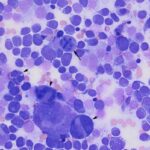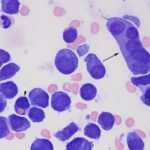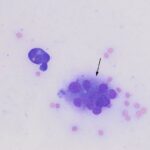Bone marrow from a dog
Case information
A 3-year-old spayed female Golden Retriever was presented to Cornell University Animal Hospital’s (CUHA) Internal Medicine Department for evaluation of lethargy and pancytopenia. The patient had displayed intermittent lethargy for approximately one month prior to presentation with one episode of collapse for which the dog had been presented by the owner to the primary care veterinarian. Physical examination at that time revealed a mild fever of 102.9°F but was otherwise unremarkable. Routine laboratory tests demonstrated a pancytopenia, hypoalbuminemia and hypocholesterolemia. A resting cortisol was performed and was within reference intervals, excluding hypoadrenocorticism. A tick-borne disease panel was negative except for a positive polymerase chain reaction result for Lyme disease. Leptospira antibody titers were also negative. A course of doxycycline was instituted but there was minimal improvement in the dog’s demeanor or laboratory results. As a result, the was referred to CUHA. The patient was up to date with vaccinations and was receiving routine heartworm, flea and tick preventatives.
Upon physical examination, the patient was mildly febrile with a temperature of 102.8°F and had mild lymphadenopathy of the prescapular and right popliteal lymph nodes, in addition to a few petechaie under the tongue. Otherwise, the rest of the physical examination was unremarkable.
A complete blood count (CBC) and chemistry panel were submitted. The CBC revealed a nonregenerative normocytic normochromic anemia (hematocrit 16%; reference interval [RI], 41-58%), leukopenia (leukocytes 3.3 thous/µL; RI 5.7-14.2 thous/µL) due primarily to a severe neutropenia (0.6 thous/µL; RI 2.7-9.4 thous/µL), and profound thrombocytopenia (7 thous/µL; RI 186-545 thous/µL). The chemistry panel demonstrated mild hypoalbuminemia (2.9 g/dL; RI 3.2-4.1 g/dL) and moderate to marked hypocholesterolemia (57 mg/dL; RI 136-392 g/dL) along with some other minor, clinically insignificant abnormalities. Urinalysis was unremarkable with a urine specific gravity of 1.024. Due to the low hematocrit, blood typing was performed and a packed red cell transfusion administered. Thoracic radiographs were unremarkable and abdominal ultrasonography revealed mild uniform splenomegaly. The patient was sedated and a bone marrow aspiration performed. Representative cytologic images from the bone marrow are shown below.
Using the provided information, answer the following questions;
- What are your differential diagnoses for the cells labeled with the arrows?
- What additional diagnostic tests would you recommend to elucidate the cell of origin?
- What are your proposed mechanisms for the biochemical abnormalities?
Answers are provided on the next page.



